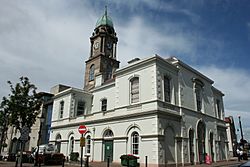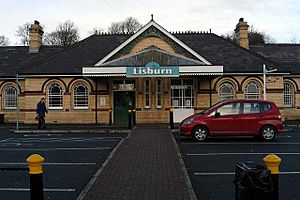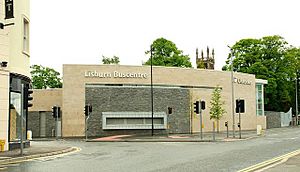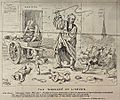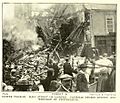Lisburn facts for kids
Quick facts for kids Lisburn
|
|
|---|---|
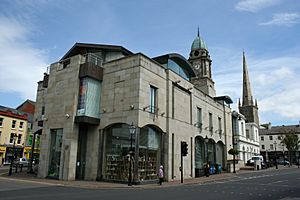 Irish Linen Museum and Christ Church Cathedral |
|
| Population | 45,370 (2011 Census) |
| • Belfast | 8 miles |
| District |
|
| County | |
| Country | Northern Ireland |
| Sovereign state | United Kingdom |
| Post town | LISBURN |
| Postcode district | BT27, BT28 |
| Dialling code | 028 |
| Police | Northern Ireland |
| Fire | Northern Ireland |
| Ambulance | Northern Ireland |
| EU Parliament | Northern Ireland |
| UK Parliament |
|
| NI Assembly |
|
Lisburn ( from Irish: Lios na gCearrbhach) is a city in Northern Ireland. It is 8 mi (13 km) southwest of Belfast city centre, on the River Lagan, which forms the boundary between County Antrim and County Down. First laid out in the 17th century by English and Welsh settlers, with the arrival of French Huguenots in the 18th century, the town developed as a global centre of the linen industry.
In 2002, as part of Queen Elizabeth's Golden Jubilee celebrations, the predominantly unionist borough was granted city status alongside the largely nationalist town of Newry. With a population of 45,370 in the 2011 Census. Lisburn was the third-largest city in Northern Ireland. In the 2016 reform of local government in Northern Ireland Lisburn was joined with the greater part of Castlereagh to form the Lisburn City and Castlereagh District with a combined population of over 130,000.
Contents
Name
The town was originally known as Lisnagarvy (also spelt Lisnagarvey, Lisnegarvey, Lisnegarvy, Lisnegarvagh or Lisnagarvagh) after the townland in which it formed. This is derived from Irish Lios na gCearrbhach, meaning 'ringfort of the gamesters/gamblers'.
The origin of the town's current name is uncertain. The modern spelling Lisburn first appears in a January 1662 entry in church records. After February 1662, the name Lisnagarvy is no longer found in the records. It is commonly believed that the town was renamed after being burnt during the Irish Rebellion of 1641. In his book Lisburn Cathedral and Its Past Rectors (1926), Reverend WP Carmody argues "This seems to be most improbable; after twenty years the burning would be a memory, and the loyal people of the town would not be disposed to give it a name that would be forever reminiscent of its destruction by rebels". There is evidence that the name existed even at the time of the rebellion. In the depositions concerning the rebellion, an English soldier stated on 9 June 1653 that the rebels entered the town of Lisnagarvy at "a place called Louzy Barne". Carmody believes that, in the town's early days, there were two co-existing ringforts: Lisnagarvy to the north and Lisburn to the south. He suggests that both names come from Irish and concludes: "Lisburn, being shorter and more easily pronounced by the English settlers, became the familiar name and Lisnagarvey gradually dropped out".
The original name is still used in the titles of some local schools and sports teams.
History
Lisburn's original site was a fort located north of modern-day Wallace Park. In 1609 James I granted Sir Fulke Conway, a Welshman of Norman descent, the lands of Killultagh in southwest County Antrim. During the 1620s the streets of Lisburn were laid out just as they are today: Market Square, Bridge Street, Castle Street and Bow Street. Conway brought over many English and Welsh settlers during the Ulster Plantation; he also had a manor house built on what is now Castle Gardens, and in 1623, a church on the site of the current cathedral. In 1628, Sir Edward Conway, brother to the now deceased Sir Fulke, obtained a charter from King Charles I granting the right to hold a weekly market. This is still held in the town every Tuesday. The Manor House was destroyed in the accidental fire of 1707 and was never rebuilt; the city's Latin motto, Ex igne resurgam ("Out of the fire I shall arise"), is a reference to this incident.
Lisburn is also known as the birthplace of Ireland's linen industry, which was established in 1698 by Louis Crommelin and other Huguenots. An exhibition about the Irish linen industry is now housed in the Irish Linen Centre, which can be found in the old Market House in Market Square.
In 1920, disturbances related to the ongoing Irish War of Independence saw almost all of Lisburn's Catholic businesses burned out and many of the town's Catholic population forced to flee. The town was one of the first to recruit special constables, who went on to become part of Northern Ireland's Ulster Special Constabulary.
The Cold War
Between 1954 and 1992 Lisburn contained the operational headquarters of No 31 Belfast Group Royal Observer Corps who operated from a protected nuclear bunker on Knox Road within Thiepval Barracks. Converted from a 1940s Anti-aircraft Operations Room (AAOR), the bunker would support over one hundred ROC volunteers and a ten-man United Kingdom Warning and Monitoring Organisation warning team responsible for the four-minute warning in the event of a nuclear strike on the UK. The ROC would also have detected radioactive fallout from the nuclear bursts and warned the public of approaching fallout.
The two organisations were disbanded in 1992 at the end of the Cold War. In 2007 a commemorative plaque was mounted on the wall of the nuclear bunker which still stands, in recognition of the service of ROC volunteers in Northern Ireland.
The Troubles
Areas
North Lisburn
The north and south divide in Lisburn can be seen either side of the railway line that goes through the centre of the city. North Lisburn is home to many of the residential neighbourhoods, and contains the notable landmarks of the Theipval Barracks, and the Laurelhill Sportszone.
Demography
| Historical population | ||
|---|---|---|
| Year | Pop. | ±% |
| 1821 | 4,684 | — |
| 1831 | 5,745 | +22.7% |
| 1841 | 6,284 | +9.4% |
| 1851 | 6,533 | +4.0% |
| 1861 | 7,462 | +14.2% |
| 1871 | 7,876 | +5.5% |
| 1881 | 10,755 | +36.6% |
| 1891 | 12,250 | +13.9% |
| 1901 | 11,461 | −6.4% |
| 1911 | 12,388 | +8.1% |
| 1926 | 12,406 | +0.1% |
| 1937 | 13,042 | +5.1% |
| 1951 | 14,781 | +13.3% |
| 1961 | 17,700 | +19.7% |
| 1966 | 21,522 | +21.6% |
| 1971 | 31,836 | +47.9% |
| 1981 | 82,091 | +157.9% |
| 1991 | 99,458 | +21.2% |
| 2001 | 71,465 | −28.1% |
| 2011 | 45,370 | −36.5% |
| Figures for 1981 and 1991 are the census figures for Lisburn City Council, which covered a larger area than the former county borough. The figure for 2001 is for Lisburn Urban Area. The figure for 2011 is for Lisburn City Settlement. | ||
2011 Census
On Census Day (27 March 2011) the usually resident population of Lisburn City Settlement was 45,370 accounting for 2.51% of the NI total.
- 97.51% were from the white (including Irish Traveller) ethnic group;
- 22.24% belong to or were brought up Catholic and 67.32% belong to or were brought up in a 'Protestant and other (non-Catholic) Christian (including Christian related)' and
- 67.65% indicated that they had a British national identity, 11.32% had an Irish national identity and 29.04% had a Northern Irish national identity.
Respondents could indicate more than one national identity
On Census Day, in Lisburn City Settlement, considering the population aged 3 years old and over:
- 3.72% had some knowledge of Irish;
- 6.51% had some knowledge of Ulster-Scots; and
- 3.25% did not have English as their first language.
Transport
Rail
The Lisburn railway station was opened on 12 August 1839. The railway remains a popular means of transport between Lisburn and Belfast, with the express trains taking 10–15 minutes to reach Belfast's Great Victoria Street. The train also links the city directly with Newry, Portadown, Lurgan, Moira and Bangor. The station also has services to Dublin Connolly in the city of Dublin, with three trains per day stopping at the station. All railway services from the station are provided by Northern Ireland Railways, a subsidiary of Translink. The city is also served by Hilden railway station.
Bus
Ulsterbus provides various bus services that connect the city with Belfast city centre, which lies eight miles northeast. These services generally operate either along Belfast's Lisburn Road or through the Falls area in west Belfast. In addition to long-distance services to Craigavon, Newry and Banbridge, there is also a network of buses that serve the rural areas around the city, such as Glenavy and Dromara; as well as an hourly bus service 6:00 am – 6:00 pm Monday-Saturday to Belfast International Airport.
The city has a network of local buses, serving the local housing developments and amenities. These are operated by Ulsterbus.
A new "Buscentre", provided by the regional public transport provider Translink, opened on 30 June 2008 at the corner of Smithfield Street and the Hillsborough Road. It replaced the shelters that formerly stood in Smithfield Square.
Road
The city has a favourable position on the Belfast-Dublin corridor, being connected with the former by the M1 motorway from which it can be accessed through junctions 3, 6, 7 and 8. The A1 road to Newry and Dublin deviates from the M1 at the Sprucefield interchange, which is positioned one mile southeast of the city centre. An inner orbital route was formed throughout the 1980s which has permitted the city centre to operate a one-way system as well as the pedestrianisation of the Bow Street shopping precinct. In addition to this, a feeder road leading from Milltown on the outskirts of Belfast to Ballymacash in north Lisburn, was opened in 2006. This route connects with the A512 and permits traffic from Lisburn to easily access the M1 at junction 3 (Dunmurry) thus relieving pressure on the southern approaches to the city.
Inland waterways
The Lagan Canal passes through Lisburn. This connected the port of Belfast to Lough Neagh, reaching Lisburn in 1763 (although the full route to Lough Neagh was not complete until 1793). Prior to World War II the canal was an important transportation route for goods, averaging over 307,000 tons of coal per year in the 1920s. Following competition from road transport, the canal was formally closed to navigation in 1958, and grew derelict. A short stretch and lock in front of Lisburn Council offices was restored to use in 2001.
Cycling
Lisburn is served by National Cycle Route 9, connecting the city with Belfast with Newry. The route is planned to eventually connect with Dublin.
Climate
As with the rest of the British Isles, Lisburn experiences a maritime climate with cool summers and mild winters. The nearest official Met Office weather station for which online records are available is at Hillsborough, about 3 miles south south west of the city centre.
Averaged over the period 1971–2000 the warmest day of the year at Hillsborough will reach 24.3 °C (75.7 °F), although 9 out of 10 years should record a temperature of 25.1 °C (77.2 °F) or above.
Averaged over the same period, the coldest night of the year typically falls to −6.0 °C (21.2 °F) and on 37 nights air frost was observed.
Typically annual rainfall falls just short of 900 mm, with at least 1 mm falling on 154 days of the year.
| Climate data for Hillsborough 116 m asl, 1971–2000, Extremes 1960–2005 (Weather Station 3.0 Miles SSW of Lisburn) | |||||||||||||
|---|---|---|---|---|---|---|---|---|---|---|---|---|---|
| Month | Jan | Feb | Mar | Apr | May | Jun | Jul | Aug | Sep | Oct | Nov | Dec | Year |
| Record high °C (°F) | 14.7 (58.5) |
15.8 (60.4) |
19.4 (66.9) |
22.8 (73.0) |
23.8 (74.8) |
28.1 (82.6) |
29.5 (85.1) |
28.4 (83.1) |
24.5 (76.1) |
21.1 (70.0) |
15.8 (60.4) |
14.5 (58.1) |
29.5 (85.1) |
| Average high °C (°F) | 6.9 (44.4) |
7.1 (44.8) |
8.9 (48.0) |
10.9 (51.6) |
14.0 (57.2) |
16.4 (61.5) |
18.3 (64.9) |
18.0 (64.4) |
15.5 (59.9) |
12.4 (54.3) |
9.2 (48.6) |
7.6 (45.7) |
12.1 (53.8) |
| Average low °C (°F) | 1.4 (34.5) |
1.6 (34.9) |
2.6 (36.7) |
3.5 (38.3) |
5.8 (42.4) |
8.6 (47.5) |
10.8 (51.4) |
10.6 (51.1) |
8.9 (48.0) |
6.5 (43.7) |
3.4 (38.1) |
2.2 (36.0) |
5.5 (41.9) |
| Record low °C (°F) | −12.2 (10.0) |
−7.8 (18.0) |
−10.0 (14.0) |
−4.9 (23.2) |
−3.3 (26.1) |
0.0 (32.0) |
2.5 (36.5) |
1.8 (35.2) |
−1.2 (29.8) |
−4.5 (23.9) |
−8.3 (17.1) |
−11.5 (11.3) |
−12.2 (10.0) |
| Average precipitation mm (inches) | 88.87 (3.50) |
61.65 (2.43) |
68.23 (2.69) |
58.03 (2.28) |
59.44 (2.34) |
62.45 (2.46) |
57.9 (2.28) |
77.89 (3.07) |
79.98 (3.15) |
91.85 (3.62) |
84.72 (3.34) |
91.03 (3.58) |
882.04 (34.74) |
People
- Sir Richard Wallace created baronet in 1871 and was Member of Parliament for Lisburn from 1873 to 1885.
- David Trimble lives within the city.
- Senior Ulster Defence Association leader John McMichael (1948–1987) was a native of Lisburn.
- Linguist, academic and author David Crystal OBE was born in Lisburn in 1941.
- Richard Dormer, Actor.
- Damien Johnson, Northern Irish international footballer was born here.
- Singer-songwriter Duke Special was born in Lisburn in 1971.
- Mary Peters lives in Lisburn.
- Barry Fitzgerald was born in Lisburn in 1972.
- Jonny Ross, Northern Irish bowler from Lisburn.
- Henry Munro (United Irishman)
- Sam Cree playwright.
- Anna Cheyne 1926–2002 Artist and sculptor long time resident of Lisburn.
- Donna Traynor. Journalist born in Lisburn.
- Sir John Milne Barbour, 1st Baronet JP, DL (1868–1951) a Northern Irish politician and baronet.
- John Doherty Barbour JP DL (1824–1901) Irish industrialist and politician.
- Lillian Margaret Metge (1871–1954) Militant suffragette, who bombed Lisburn Cathedral in 1914, lived here
- John Grubb Richardson (1813–1891) Irish linen merchant, industrialist and philanthropist who founded the model village of Bessbrook
- William H. Conn (1895–1973) was an Irish cartoonist, illustrator, watercolourist and poster artist.
- Samuel McCloy (1831–1904) was an Irish painter
- John Jeffers (1822–1890) member of the Wisconsin State Assembly
- Kristian Nairn, portrayed Hodor in Game Of Thrones
Sport
In November 2012 the Award of 2013 European City of Sport was officially handed over to Lisburn at a presentation ceremony at the European Parliament in Brussels.
Football
- Lisburn Distillery is an association football club playing in the NIFL Championship and based at Ballyskeagh, on the outskirts of the city.
- Ballymacash Rangers F.C. play in the Mid-Ulster Football League.
- Lisburn Rangers F.C. play in the Northern Amateur Football League.
- Downshire Young Men F.C. play in the Northern Amateur Football League.
- Warren Young Men
- Ballymacash Young Men F.C.
- Lambeg Rangers F.C.
- FC United Lisburn
- South Antrim F.C.
- 1st Lisburn F.C.
- The city remains a key centre for youth football, hosting most games in the 'Lisburn Junior Invitational League', an amateur youth league which incorporates many teams from across the east of Ulster.
Other sports
- Lisburn Cricket Club
- Lisburn Racquets Club
- St. Patrick's GAA
- Down Royal racecourse is located near the city
Images for kids
-
"Education indeed! What next? The people of Lisburn commencing to think for themselves will become absolutely uncontrollable. Ha you infernal young brats, there is not one of your parents, Widow or ot not, whose rent I will not double." Comment on Lord Hertford's agent, the Rev. James Stannus, Rector of Lisburn Cathedral, circa 1850
-
The Old Town Hall in Castle Street
See also
 In Spanish: Lisburn para niños
In Spanish: Lisburn para niños



